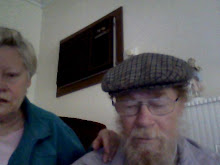All three, perhaps. Or only the last?
Anyway the best of tessellations are eternally very pleasing, from all perspectives.
Many people say they are their favourite artform, (but quite a few people are too easily pleased.)
It seems a pity that so few people have done very good examples of animalesque tessellations. Escher first, of course, did a few really good ones - Sea-Horses, Birds, Fishes, Bull-Dogs, Horsemen - but even in his case, most of his designs are heavily stylized creatures or even grotesqueries: not my cup of tea. I like animals which look as much like the real thing as possible, flying Unicorns and fanciful Demons don't interest me.
One thing Escher didn't do though was to tessellate just a part of a creature, e.g. a Cat's head, and call it a Cat tessellation. I don't think much of this sort of pattern, so typical of many to be found on the www. Escher's designs were always whole creatures, and so if I might mention it are my own, in fact I would not dream of displaying amputational tessellations.
A third class of tessellation which I don't esteem very highly are designs in which the repeating shapes are little more than amoebic blobs which are then internally embellished with limbs and other bodily features to create the animal-appearance. (Eyes, though, are universally necessary, after all they are always internalised, unlike say tails or ears or legs.) My demands on my own designs are that the repeating shapes themselves define the creatures concerned, so any one piece may stand alone as what it's supposed to look like.
So there's three "filters" for what I reckon are truly worthy tessellations: real creatures, whole creatures, self-defined creatures. These filters are not matters of opinion, but manifestly relate to real aspects of the designs: either the patterns pass or they don't. I care only marginally about the quality of the surface decoration, though I acknowledge the use of airbrush and other techniques in improving the eye appeal of patterns: it's the outline that is the main consideration, the rest is window-dressing.
Several wwwebsites display collections of other people's tessellations. Andrew Crompton in England and Patrick Snels in Holland both maintain extensive galleries of adults' designs, while worldofescher in the USA runs an ongoing competition which is mostly frequented by children, and American children at that. Sorry if that last bit sounds putdownish, but if the filters as detailed above are applied to the children's efforts almost all would fail. The reasons for this are twofold: One, decent designs are devilish difficult to do, and two, the kids' teachers in the USA seem to lead them to approach the drafting of patterns from what I think is the wrong end: first the youngsters are told to draw random tessellating blobs, then to try to find suggestions of animalesque shapes within those blobs and to embellish them to try to play up the animal appearance. The result is that the "Hall of Fame" examples are mostly pretty forgettable. Truth.
Andrew and Patrick have been collecting tessellation art for years, and I thank them both for their efforts in bringing post-Escher tessellators to the public. It appears that between them they show examples from most of the "serious" adult tessellators. Sadly, I must insist that the filtering process would remove most of the designs from the top eschelons of Escheresquerie.
Why am I so hard to please? I hear you cry. Because I am! Because I really truly ADORE tessellations, I'm obsessive if you like, but I can't help feeling that the plethora of inferior designs swamping the Websites devalues the experience of trawling them.
Wednesday, December 31, 2008
Subscribe to:
Post Comments (Atom)



No comments:
Post a Comment